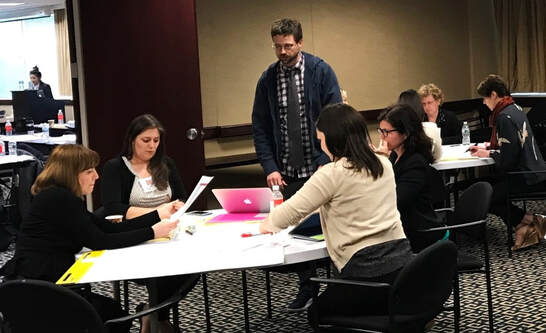Design Thinking
|
The Design Thinking Program focuses on innovative thinking as a means of designing products and services that meet real human needs. You will learn new ways to manage complexity and create sustainable products benefiting both internal and external stakeholders. Throughout the program, you will be guided by professional designers and educators who are experts in their field. Our format is designed to train and develop your ideation and synthesis skills and give you insights to help you move innovation initiatives forward within your organization.
|
Course Curriculum
Module1: Introduction to Design Thinking
Learn a practical definition of Design Thinking and how it's used to solve business, technology, and social problems across industries.
Module 2: Designing for Empathy
Use case studies to understand and apply empathy in business environments and discover the value of empathy-based research and elicitation.
Module 3: Introduction to Visualization
Discover the most common visualization tools in design thinking and the best methods for collaborating to explore and understand ideas.
Module 4: Persona & Journey Map Design
Understand the importance of customer experience-based visualizations. Explore how they help define customer attributes and their experiences with your products, services and stakeholders.
Module 5: Ideation in the Design Thinking process
Discover the concept of ideation as a process for developing, communicating and synthesizing prescriptive ideas to others to solve the right problem.
Module 6: Prototyping
Uncover potential approaches for prototyping concepts, products and services that solve problems.
Module 7: Validation
Leverage previous module knowledge of ideation and prototype design to help design thinkers properly test and validate ideas and prototypes.
Module 8: Implementation & Application
Create a plan for implementing design thinking principles and tools at your organization and for aligning with the ROI of internal projects and stakeholders.
Learn a practical definition of Design Thinking and how it's used to solve business, technology, and social problems across industries.
- Define design thinking as an effective approach to creative problem-solving.
- Understand how human-centered design and methodology influence Design Thinking.
- Review practices and case studies of Design Thinking in the real world.
Module 2: Designing for Empathy
Use case studies to understand and apply empathy in business environments and discover the value of empathy-based research and elicitation.
- Identify effective approaches and tools for research.
- Design conversations and interviews that honor stakeholders.
- Frame statements that facilitate problem-solving.
Module 3: Introduction to Visualization
Discover the most common visualization tools in design thinking and the best methods for collaborating to explore and understand ideas.
- Align the right visualizations to the right design thinking tools.
- Learn the visualization tools that best fit specific challenges.
- Explore the use of visualization tools in real-life scenarios.
Module 4: Persona & Journey Map Design
Understand the importance of customer experience-based visualizations. Explore how they help define customer attributes and their experiences with your products, services and stakeholders.
- Create personas that describe stakeholder characteristics.
- Build journey maps that help define critical moments of truth.
- Identify the right tools for success measurement in customer experience.
Module 5: Ideation in the Design Thinking process
Discover the concept of ideation as a process for developing, communicating and synthesizing prescriptive ideas to others to solve the right problem.
- Develop creative processes for developing new ideas.
- Understand mind-mapping and brainstorming approaches.
- Learn best practices for ideation workshops.
Module 6: Prototyping
Uncover potential approaches for prototyping concepts, products and services that solve problems.
- Understand low and high-fidelity prototyping.
- Design approaches for bringing ideas to life.
- Discuss prototyping approaches and tools.
Module 7: Validation
Leverage previous module knowledge of ideation and prototype design to help design thinkers properly test and validate ideas and prototypes.
- Identify methods for researching and validating outcomes.
- Evaluate recommendations for stakeholder collaboration and participation.
- Develop considerations for design validation.
Module 8: Implementation & Application
Create a plan for implementing design thinking principles and tools at your organization and for aligning with the ROI of internal projects and stakeholders.
- Develop processes for deployment and launch.
- Explore collaboration methods with stakeholders and success partners.
- Design plans for applying design thinking at your organization.
Get your students top programs and best-in-class curriculum with Zschool |
Become a Zschool Partner
To learn more about bringing the Design Thinking Program to your university, and how it helps executives drive real business results, contact us at 1.844.669.7884 to speak with a program counselor.

